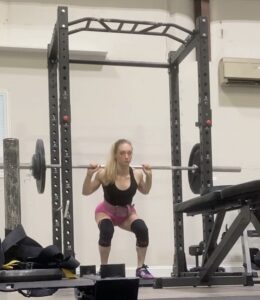
Knee Valgus in the Squat
Knee valgus or a valgus twitch in the squat refers to the inward collapse of the knees during a squat exercise. It is a common movement pattern deviation seen in many individuals, especially when performing deep squats or when lifting heavy loads.
Knee valgus during squats can be harmful as it puts excessive stress on the knee joint and can increase the risk of knee injuries. However, knee valgus or valgus twitch is not necessarily harmful.
What is Knee Valgus
Knee valgus, also known as knock knees, is a term used to describe a condition in which the knees collapse inward during activities such as squatting, jumping, or running. In knee valgus, the thigh bone (femur) and shin bone (tibia) do not align vertically, causing the knees to move closer to each other. This misalignment may put additional stress on the structures of the knee joint, leading to potential discomfort, instability, and an increased risk of knee injuries such as ligament tears or patellofemoral pain syndrome.
Knee valgus is often associated with weak hip abductors and external rotator muscles, imbalances in lower limb strength, improper movement mechanics, or structural abnormalities. Correcting knee valgus typically involves targeted exercises to strengthen the hip and thigh muscles, improving movement mechanics, and addressing any underlying factors contributing to the condition.
Causes of Knee Valgus in the Squat
Here are some of the common causes of valves collapse in the squat.
1. Weak hip abductor and external rotator muscles: Weakness in the gluteus medius and other hip muscles can lead to inadequate control and stability of the knee joint, causing it to collapse inward.
2. Imbalances in lower limb strength: Muscle imbalances between the quadriceps and hamstring muscles, or between the medial and lateral muscles of the thigh, can contribute to knee valgus.
3. Improper movement mechanics: Poor technique, such as incorrect foot placement, inadequate hip and ankle mobility, or a lack of core stability, can result in knee valgus during squats.
How to Correct Knee Valgus in the Squat
To correct knee valgus in squats, it is important to address the underlying causes. This may involve:
1. Strengthening the hip muscles: Focusing on exercises that target the gluteus medius, hip external rotators, and other hip-stabilizing muscles can help improve control over knee movement.
2. Addressing muscle imbalances: Working on balancing the strength and flexibility of the muscles around the knee, hip, and thigh can help prevent knee valgus.
3. Improving movement mechanics: Practicing proper squat technique, ensuring proper foot position, maintaining a neutral spine, and improving hip and ankle mobility can all contribute to reducing knee valgus.
It is recommended to consult with a fitness professional or physical therapist who can assess your specific movement patterns, muscle imbalances, and provide personalized recommendations for correcting knee valgus in the squat.
What is Valgus Twitch in the Squat?
A valgus twitch is an automatic, involuntary “twitch” of the knees towards each other during the ascent in the squat exercise. Unlike a valgus collapse, the valgus twitch is not necessarily harmful. The valgus twitch is often seen in advanced weight lifters and powerlifters during the ascent on the squat.
This involuntary valgus twitch may show up as these strength athletes work with loads close to their one rep max.
As long as this movement strategy does not cause knee pain, there is no evidence to believe it is harmful or is due to a weakness in the glutes or hip external rotators.
A valgus twitch may actually increase strength in the squat in very experienced weightlifters. These lifters may have stronger hip extension capabilities in slight hip adduction and internal rotation.
If you are an experienced weightlifter or powerlifter, you may experience a slight valgus twitch when you work with challenging loads on the squat. As long as the valgus collapse is not severe and does not cause any pain, there is no need to try to correct this movement strategy.
Is Knee Valgus Always Bad?
As we have discussed, knee valgus can indicate muscle imbalances and movement timing errors.
A quick valgus twitch is not necessarily indicative of movement deficiencies and may actually improve strength output in the squat in advanced weightlifters and powerlifters. As long as the valgus collapse is extremely brief and does not cause knee pain, it’s not always a bad thing.
Final Thoughts
Knee valgus in the squat is not always a death sentence for the knees. If your knee valgus is severe, more extreme on one leg than another, causes knee pain or dysfunction, you may want to work with a fitness professional to improve your hip strength and technique to avoid valgus collapse in the squat.
On the other hand, if you are an advanced barbell squatter with an involuntary valgus twitch in the ascent of the squat when working with heavy loads, you may have nothing to worry about at all.
What do you think? Please let me know in the comment section below.